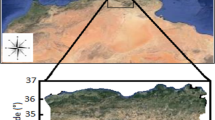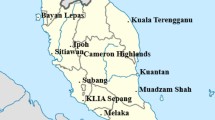Abstract
Soil temperature is an important meteorological parameter which influences a number of processes in agriculture, hydrology, and environment. However, soil temperature records are not routinely available from meteorological stations. This work aimed to estimate daily soil temperature using the coactive neuro-fuzzy inference system (CANFIS) in arid and semiarid regions. For this purpose, daily soil temperatures were recorded at six depths of 5, 10, 20, 30, 50, and 100 cm below the surface at two synoptic stations in Iran. According to correlation analysis, mean, maximum, and minimum air temperatures, relative humidity, sunshine hours, and solar radiation were selected as the inputs of the CANFIS models. It was concluded that, in most cases, the best soil temperature estimates with a CANFIS model can be provided with the Takagi–Sugeno–Kang (TSK) fuzzy model and the Gaussian membership function. Comparison of the models’ performances at arid and semiarid locations showed that the CANFIS models’ performances in arid site were slightly better than those in semiarid site. Overall, the obtained results indicated the capabilities of the CANFIS model in estimating soil temperature in arid and semiarid regions.



Similar content being viewed by others
References
Aghakhani S (2010) Neuro-fuzzy architecture based on complex fuzzy logic. M.Sc. Thesis in Software Engineering and Intelligent Systems, University of Alberta, 134 pp
Aytek A (2009) Co-active neuro-fuzzy inference system for evapotranspiration modeling. Soft Comput 13(7):691–700
Bilgili M (2010) Prediction of soil temperature using regression and artificial neural network models. Meteor Atmos Phys 110:59–70
Bilgili M, Sahin B, Sangun L (2013) Estimating soil temperature using neighboring station data via multi-nonlinear regression and artificial neural network models. Environ Monit Assess 185:347–358
Camps-Valls G, Gomez-Chova L, Calpe-Maravilla J, Martin-Guerrero JD, Soria-Olivas E, Alonso-Chorda L, Moreno J (2004) Robust support vector method for hyperspectral data classification and knowledge discover. Trans Geosci Rem Sens 42(7):1530–1542
Chang FJ, Chang YT (2006) Adaptive neuro-fuzzy inference system for prediction of water level in reservoir. Adv Water Resour 29(1):1–10
Farouk Abdel Hady Mohamed M (2005) A new approach for extracting fuzzy rules using artificial neural networks. M.Sc. Thesis in Computer Science, Cairo University, 122 pp
Ghahreman N, Bazrafshan J, Gharekhani A (2010) Trend analysis of soil surface temperature in several regions of Iran. 19th World Congress of Soil Science, Soil Solutions for a Changing World, 1–6 August 2010, Brisbane, Australia
Hardalac F, Ozan AT, Baris N, Ergun U, Serhatlioglu S, Guler I (2004) The examination of the effects of obesity on a number of arteries and body mass index by using expert systems. J Med Syst 28(2):129–142
Hu Q, Feng S (2003) A daily soil temperature dataset and soil temperature climatology of the contiguous United States. J Appl Meteorol 42:1139–1156
Jang JSR, Sun CT, Mizutani E (1997) Neuro-fuzzy and soft computing: a computational approach to learning and machine intelligence. Prentice-Hall, New Jersey
Jebamalar AS, Abraham Thambi Raja S, Jeslin Sunitha Bai S (2012) Prediction of annual and seasonal temperature variation using artificial neural network. Indian J Radio Space Phys 41:48–57
Liu X, Mei X, Li Y, Zhang Y, Wang Q, Jensen JR, Porter JR (2009) Calibration of the Angstrom–Prescott coefficients (a, b) under different time scales and their impacts in estimating global solar radiation in the yellow river basin. Agric For Meteor 149:697–710
Loukas YL (2001) Adaptive neuro-fuzzy inference system: an instant and architecture-free predictor for improved QSAR studies. J Med Chem 44:2772–2783
Mazou E, Alvertos N, Tsiros IX (2012) Soil temperature prediction using time-delay neural networks. In: CG, Helmis and PT Nastos (eds.), Advances in Meteorology, Climatology and Atmospheric Physics, Springer Atmospheric Sciences, doi:10.1007/978-3-642-29172-2_87
Moradi I (2009) Quality control of global solar radiation using sunshine duration hours. Energy 34(1):1–6
NeuroDimension, Inc. (2005) Developers of NeuroSolutions v5.01: Neural Network Simulator. The World Wide Web address is www.nd.com, Gainesville, FL.
Palz W, Kasten F, Golchert HJ, Dogniaux R, Lemoine M (1984) European Solar Radiation Atlas. Vol. I: Global Radiation on Horizontal Surfaces. Second Improved and Extended Edition. Report-Nr. EUR9344
Parthiban L, Subramanian R (2007) Intelligent heart disease prediction system using CANFIS and genetic algorithm. Int J Biol Life Sci 3(3):157–160
Saemi M, Ahmadi M (2008) Integration of genetic algorithm and a coactive neuro-fuzzy inference system for permeability prediction from well logs data. Transp Porous Med 71:273–288
Shu C, Ouarda TBMJ (2008) Regional flood frequency analysis at ungauged sites using the adaptive neuro-fuzzy inference system. J Hydrol 349:31–43
Singh TN, Verma AK, Sharma PK (2007) A neuro-genetic approach for prediction of time dependent deformational characteristic of rock and its sensitivity analysis. Geotech Geol Eng 25:395–407
Tabari H, Sabziparvar AA, Ahmadi M (2011) Comparison of artificial neural network and multivariate linear regression methods for estimation of daily soil temperature in an arid region. Meteor Atmos Phys 110:135–142
Tabari H, Hosseinzadeh Talaee P, Abghari H (2012) Utility of coactive neuro-fuzzy inference system for pan evaporation modeling in comparison with multilayer perceptron. Meteor Atmos Phys 116:147–154
Takagi T, Sugeno M (1985) Fuzzy identification of systems and its application to modeling and control. IEEE Trans Syst Man Cybern 15(1):116–132
Talei A, Chua LHC, Quek C (2010) A novel application of a neuro-fuzzy computational technique in event-based rainfall–runoff modeling. Expert Syst Appl 37(12):7456–7468
Tymvios FS, Jacovides CP, Michaelides SC, Scouteli C (2005) Comparative study of Angstrom’s and artificial neural networks’ methodologies in estimating global solar radiation. Sol Energy 78:752–762
Wu W, Tang X-P, Guo N-J, Yang C, Liu H-B, Shang Y-F (2013) Spatiotemporal modeling of monthly soil temperature using artificial neural networks. Theor Appl Climatol 113:481–494
Acknowledgments
The authors wish to express their gratitude to the Islamic Republic of Iran Meteorological Organization (IRIMO) for access to the meteorological data.
Author information
Authors and Affiliations
Corresponding author
Rights and permissions
About this article
Cite this article
Hosseinzadeh Talaee, P. Daily soil temperature modeling using neuro-fuzzy approach. Theor Appl Climatol 118, 481–489 (2014). https://doi.org/10.1007/s00704-013-1084-9
Received:
Accepted:
Published:
Issue Date:
DOI: https://doi.org/10.1007/s00704-013-1084-9




